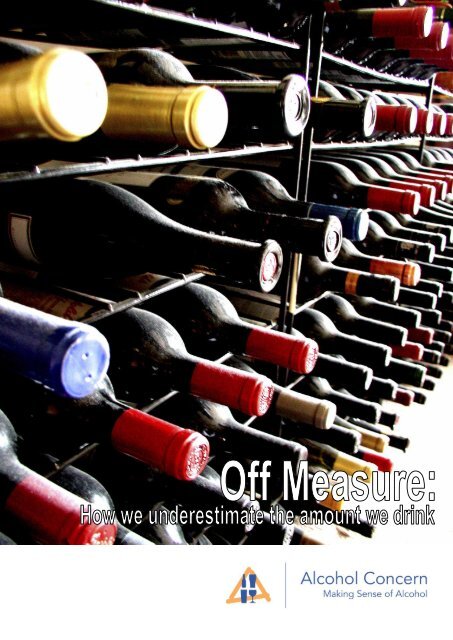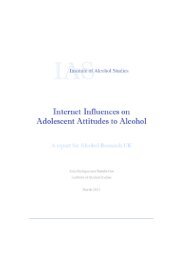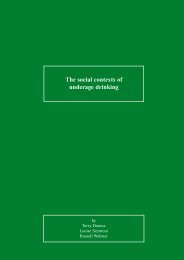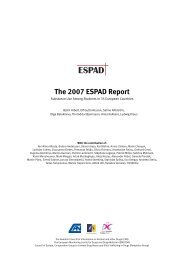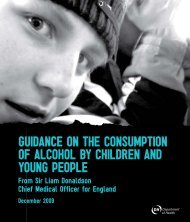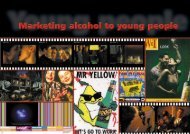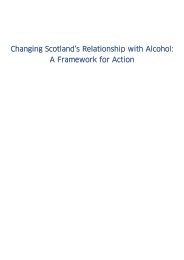Off Measure: How we underestimate the amount ... - Alcohol Concern
Off Measure: How we underestimate the amount ... - Alcohol Concern
Off Measure: How we underestimate the amount ... - Alcohol Concern
Create successful ePaper yourself
Turn your PDF publications into a flip-book with our unique Google optimized e-Paper software.
<strong>Alcohol</strong> <strong>Concern</strong><strong>Alcohol</strong> <strong>Concern</strong> is <strong>the</strong> national agency on alcohol misuse campaigning for effectivealcohol policy and improved services for people whose lives are affected by alcoholrelatedproblems.This report was written and researched by Mark A Bellis, Karen Hughes, Penny ACook, Michela Morleo, Centre for Public Health, Liverpool John Moores University,Kingsway House, Hatton Garden, Liverpool, L3 2AJ, UKPublished by <strong>Alcohol</strong> <strong>Concern</strong>, 64 Leman Street, London E1 8EU Tel: 020 7264 0510,Fax: 020 7488 9213, Email: contact@alcoholconcern.org.uk,Website: www.alcoholconcern.org.ukCopyright: <strong>Alcohol</strong> <strong>Concern</strong> December 2009All rights reserved. No part of this publication may be produced, stored in a retrievalsystem, or transmitted by any means without <strong>the</strong> permission of <strong>the</strong> publishers and <strong>the</strong>copyright holders.<strong>Alcohol</strong> <strong>Concern</strong> is a registered charity no. 291705 and a company limited byguarantee registered in London no. 1908221.<strong>Off</strong> <strong>Measure</strong>: <strong>How</strong> <strong>we</strong> <strong>underestimate</strong> <strong>the</strong> <strong>amount</strong> <strong>we</strong> drink 2
Contents PageSummary........................................................................................................................... 2Introduction ...................................................................................................................... 3Calculating <strong>the</strong> true level of consumption among adult drinkers ............................... 3Accounting for <strong>the</strong> differences in data .......................................................................... 4Problems in survey design ............................................................................................. 5Conclusion ....................................................................................................................... 7References ........................................................................................................................ 8
<strong>Off</strong> <strong>Measure</strong>Introduction<strong>Off</strong> <strong>Measure</strong>: <strong>How</strong> <strong>we</strong> <strong>underestimate</strong> <strong>the</strong> <strong>amount</strong> <strong>we</strong> drink 1
SummaryRoutine survey measures of alcohol consumption in <strong>the</strong> UK grossly <strong>underestimate</strong> actualconsumption. A new analysis carried out by Liverpool John Moores University finds that<strong>the</strong> discrepancy bet<strong>we</strong>en alcohol surveys calculating consumption and actual alcoholsales equals 430 million units a <strong>we</strong>ek. This is <strong>the</strong> equivalent of a bottle of wine per adultdrinker per <strong>we</strong>ek going unaccounted for in <strong>the</strong> UK.Based on sales data during 2007/08, average alcohol consumption per <strong>we</strong>ek across <strong>the</strong>UK was around 26 units per adult drinker. This does not include any alcohol consumedabroad, personally imported (legally or illegally) or bre<strong>we</strong>d at home. With levels ofabstinence having risen considerably in recent years <strong>the</strong> actual <strong>amount</strong> of alcoholconsumed per drinker may increase even when total alcohol sales remain <strong>the</strong> same orfall.There would need to be a reduction of around 184 million litres of alcohol per year insales (nearly a 1/3 of all current sales based on 2007/08 data) just for <strong>the</strong> averageconsumption of female and male drinkers to fall to 14 units and 21 units per <strong>we</strong>ekrespectively.Current survey designs to measure alcohol consumption are likely to lead to<strong>underestimate</strong>s in <strong>the</strong> size of <strong>the</strong> population being affected by alcohol-related harms.Consequently, this has risks for <strong>the</strong> urgency of <strong>the</strong> government’s current policy responseand <strong>the</strong> necessary public investment needed to reduce harms.There is an urgent need for better quality survey data on alcohol consumption patterns,<strong>the</strong> number of individuals abstaining and <strong>the</strong> rate of consumption above governmentguidelines across <strong>the</strong> UK. Work in o<strong>the</strong>r countries has shown that properly structuredsurveys can more accurately measure <strong>the</strong> majority of alcohol sold and consumed – <strong>the</strong>UK needs to learn from <strong>the</strong> way <strong>the</strong>se surveys are designed.<strong>Off</strong> <strong>Measure</strong>: <strong>How</strong> <strong>we</strong> <strong>underestimate</strong> <strong>the</strong> <strong>amount</strong> <strong>we</strong> drink 2
IntroductionFor many countries alcohol represents one of <strong>the</strong> biggest challenges facing public healthand health care systems. Figures for England suggest that in 2006, 3.2% of deaths(16,236) <strong>we</strong>re attributable to alcohol. In 2007/08 annual alcohol-related admissions tohospital exceeded 850,000; up 69% since 2002/03. 1National surveys suggest that <strong>the</strong> reported <strong>we</strong>ekly average consumption of 20% ofwomen and 31% of men exceeds 14 units and 21 units respectively * (1 unit=10mls purealcohol). 2 <strong>How</strong>ever, when non-drinkers (17% women; 11% men: population <strong>we</strong>ightedaverage based on English, 2 Scottish, 3 Welsh 4 and Nor<strong>the</strong>rn Irish 5 national surveys) areexcluded, proportions exceeding <strong>we</strong>ekly safe limits rise to around 24% of women and35% of men.High levels of alcohol consumption in <strong>the</strong> UK have prompted vigorous debate anddiscussion on <strong>the</strong> need for public health measures to alter such national drinking habits.Some measures have already been adopted (e.g. <strong>we</strong>bsites providing advice andvoluntary codes for responsible alcohol retail) but calls for o<strong>the</strong>rs (e.g. a minimum pricefor alcohol 6 ) have so far been rejected. Debate about how far regulation should gorevolves around <strong>the</strong> scale of damage caused by alcohol, whe<strong>the</strong>r a responsibly drinkingmajority should be “punished” for <strong>the</strong> behaviour of a few, or simply whe<strong>the</strong>r consumptionis already decreasing. While national surveys can usefully inform such discussions, <strong>the</strong>reis good reason to believe that <strong>the</strong>y grossly <strong>underestimate</strong> <strong>the</strong> scale of <strong>the</strong> problem andconsequently, understate <strong>the</strong> need for action.Calculating <strong>the</strong> true level of consumption among adult drinkersCalculation of <strong>the</strong> number of deaths and hospital admissions caused by drinking, socialmarketing messages about how many people drink responsibly and trend analyses (e.g.to examine if prevention interventions work) all rely, to differing extents, on nationalsurvey data. UK surveys typically estimate average <strong>we</strong>ekly consumption using a quantityfrequencymethod, asking participants to estimate how often <strong>the</strong>y drank different drink* Maximum recommended alcohol limits of 14 units per <strong>we</strong>ek for women and 21 units per <strong>we</strong>ek for men have beenreplaced by daily limits in official guidance on sensible alcohol consumption. <strong>How</strong>ever, <strong>the</strong> evidence for thoseexceeding such <strong>we</strong>ekly levels suffering increased risks of alcohol-related disease and injury remains (Jones et al2008). Fur<strong>the</strong>r, no current and historical measures are available on <strong>the</strong> proportion of people regularly (most days)exceeding 2/3 units per day for women and 3/4 per day for men. Therefore, analyses of <strong>the</strong> 14 and 21 units per <strong>we</strong>ekmeasures have been retained in this paper.<strong>Off</strong> <strong>Measure</strong>: <strong>How</strong> <strong>we</strong> <strong>underestimate</strong> <strong>the</strong> <strong>amount</strong> <strong>we</strong> drink 3
types over <strong>the</strong> last year and how much <strong>the</strong>y usually drink on any one day. The GeneralHousehold Survey suggests an average UK adult (16 years and over) consumes 13.5units per <strong>we</strong>ek 2 . This figure includes those who abstain from drinking, suggesting averageconsumption for adult drinkers only is approximately 15.7 units per <strong>we</strong>ek; around 345million litres of pure alcohol each year across <strong>the</strong> population. <strong>How</strong>ever, ano<strong>the</strong>r measureof alcohol consumption is clearance (i.e. taxation) data, which does not directly measureconsumption but represents <strong>the</strong> <strong>amount</strong> of alcohol on which taxes have been paid toallow <strong>the</strong>ir legal sale. In <strong>the</strong> year 2007/08, 570 million litres of pure alcohol <strong>we</strong>re taxed. 7This equates <strong>we</strong>ekly to 22 units per adult (16 years and over) or around 26 units perdrinking adult.The difference bet<strong>we</strong>en survey and sales data of 225 million litres per year is equivalentto 430 million units per <strong>we</strong>ek; or around 44 million bottles of wine a <strong>we</strong>ek (at 13% ABV) -this means just over one bottle per adult drinker per <strong>we</strong>ek is unaccounted for bet<strong>we</strong>ensurvey data and tax sales data.Accounting for <strong>the</strong> differences in dataTaxation figures on alcohol sales include alcohol consumed by children and non-UKresidents during visits to <strong>the</strong> UK, as <strong>we</strong>ll as that which is stored, thrown away or releasedfor sale in <strong>the</strong> UK but subsequently exported. To account for differences, this would haveto equal more than half of all alcohol consumed by those 16 years and over as measuredthrough national surveys.<strong>How</strong>ever, estimates of alcohol consumption by those under 16 years are equallyproblematic. Surveys suggest that 11-15 year olds in <strong>the</strong> UK consume less than 10million units of alcohol per <strong>we</strong>ek † ; at face value accounting for less than 2.5% of <strong>the</strong>missing consumption and even allowing for under-reporting still representing only a tinyproportion.Any suggestions that <strong>the</strong> difference bet<strong>we</strong>en sales and survey consumption are due tonon-UK nationals consuming alcohol in <strong>the</strong> UK are equally problematic. Tourism datashow that foreign nationals spent 246 million nights in <strong>the</strong> UK in 2008. 8 <strong>How</strong>ever, this isfar less than <strong>the</strong> 703 million nights spent abroad by UK residents in <strong>the</strong> same year and<strong>the</strong>ir alcohol consumption abroad is not included in taxation estimates.† Based on figures from Smoking, drinking and drug use among young people in England in 2008 11<strong>Off</strong> <strong>Measure</strong>: <strong>How</strong> <strong>we</strong> <strong>underestimate</strong> <strong>the</strong> <strong>amount</strong> <strong>we</strong> drink 4
A fur<strong>the</strong>r addition is alcohol purchased abroad or duty free and imported, legally forpersonal use or illegally for personal use or sale. Although again poorly measured, limiteddata previously suggested an average of 1.4 litres of pure alcohol per adult (15 years orover) is imported legally to <strong>the</strong> UK and 0.3 litres acquired via cross-border smuggling.Toge<strong>the</strong>r with home produced alcohol, this has been estimated at around two litres ofalcohol per person per year; or just under four units per <strong>we</strong>ek not accounted for in taxbasedestimates (2000). 9Problems in survey designIt is relatively straightforward to see how so much alcohol could be consumed withoutregistering in surveys. When recalling consumption, drinkers can ignore occasional (evenroutine) heavy drinking sessions, <strong>underestimate</strong> drink sizes and <strong>the</strong>ir alcohol content, andexclude holidays at home or abroad, special occasions (e.g. <strong>we</strong>ddings, birthdays) orcelebratory times of year (e.g. Christmas) when drinking may increase substantially. Evenwhen recollection is complete, accuracy relies on individuals nei<strong>the</strong>r exaggerating norunderestimating consumption. Fur<strong>the</strong>r, certain heavy drinkers may be underrepresentedin surveys ei<strong>the</strong>r through choice or circumstances that exclude <strong>the</strong>m from sampling (e.g.homelessness).With better sampling and more specific questions on drinking locations and types ofdrinks consumed, surveys can produce much better estimates in line with sales data. 10Ensuring that surveys capture <strong>the</strong> currently missing alcohol consumption across <strong>the</strong> UKshould be a priority. At <strong>the</strong> moment across <strong>the</strong> UK billions of units of alcohol areconveniently overlooked. Unfortunately, our national estimates of alcohol-related ill healthare partly derived from survey-based levels of consumption combined with risk formulae(i.e. risk of developing a particular disease from a continued level of alcohol consumption)from published studies. 12Methodologies for measuring consumption vary bet<strong>we</strong>en such studies 13 and to differingextents some will also <strong>underestimate</strong> alcohol consumption. <strong>How</strong>ever, assuming <strong>the</strong>yprovide relatively accurate data on how consumption relates to disease, <strong>the</strong>ir use incombination with UK surveys could grossly <strong>underestimate</strong> <strong>the</strong> burden alcohol representsto <strong>the</strong> nation’s health.Reducing this burden urgently requires an accurate understanding of how much alcoholis consumed and by whom. Survey data, which currently only represent around 60% of<strong>Off</strong> <strong>Measure</strong>: <strong>How</strong> <strong>we</strong> <strong>underestimate</strong> <strong>the</strong> <strong>amount</strong> <strong>we</strong> drink 5
sales, are a poor measure of who is consuming how much and how such consumption ischanging year on year. Equally, sales data tell us nothing about who is drinking at levelsmost likely to damage health, and understanding <strong>the</strong> relationship bet<strong>we</strong>en consumptionand ill health requires good behavioural data. 12For example, recent debate has focused on whe<strong>the</strong>r alcohol sales data indicate a fall innational alcohol consumption ‡ and whe<strong>the</strong>r such a fall should be accompanied byimprovements in population health. 14 <strong>How</strong>ever, recent years have seen increasing levelsof abstinence, meaning that total alcohol sales are now being consumed by asubstantially smaller proportion of people. In fact, as Box 1 shows, alcohol sales canconceivably fall while <strong>the</strong> <strong>amount</strong> each drinker consumes actually increases.Box 1. The importance of abstinence in interpreting alcohol sales dataLevels of abstinence increased from around 9.5% in 1992/93 to 14% when lastmeasured in 2006 (by <strong>the</strong> General Household Survey). The 1992/93 annual alcoholconsumption per person ≥16 years (by taxation) was 9.45 litres rising to 11.39 in2006/07; a rise of 1.94 litres or 20.5%. <strong>How</strong>ever, after accounting for changes inabstinence, consumption per drinker actually increased by approximately 27%;substantially more than suggested by taxation data alone. In fact, consumption wouldhave had to fall by around 0.45 litres/adult per year bet<strong>we</strong>en 1992/93 and 2006/07 justfor average consumption per drinker to have remained <strong>the</strong> same. The reasons forincreasing levels of abstinence are not <strong>we</strong>ll studied but may include changes in <strong>the</strong>demographic (e.g. age, ethnic) profile of <strong>the</strong> UK. 16‡ At <strong>the</strong> point of publication <strong>the</strong> latest clearance (taxation) data published <strong>we</strong>re 2007/08, showing a rise inalcohol taxed since 2006/07. <strong>How</strong>ever, <strong>the</strong> British Beer and Pub Association 15 , analysing calendar yearestimates, suggest a fall in sales bet<strong>we</strong>en 2007 and 2008 from 9.2 to 8.9 litres of alcohol/person/year. Aftercorrecting for abstainers this would mean <strong>the</strong> average drinker (≥16 years) consumes around 24.5units/<strong>we</strong>ek.<strong>Off</strong> <strong>Measure</strong>: <strong>How</strong> <strong>we</strong> <strong>underestimate</strong> <strong>the</strong> <strong>amount</strong> <strong>we</strong> drink 6
ConclusionWithout better intelligence on <strong>the</strong> actual patterns of alcohol consumption across <strong>the</strong> UKour efforts to change a damaging drinking culture are likely to be misdirected and policydecisions watered down along with our measures of <strong>the</strong> scale of <strong>the</strong> problem. Whileaccurate measures of drinking behaviours are not available, measuring progress intackling rising consumption and resultant harms will remain challenging. <strong>How</strong>ever, evenfor every drinker in <strong>the</strong> UK to consume 14 units (females) and 21 units (males) per <strong>we</strong>ek<strong>the</strong>re would need to be a reduction of around 184 million litres of alcohol per year in sales(2007/08 base) or nearly one third of all alcohol currently sold. This is somethingunlikely to be popular with ei<strong>the</strong>r those selling alcohol or collecting tax (considering thiscould equate to a fall of £4.7 billion in tax revenue).To discuss alcohol as a nation <strong>we</strong> need a measure of our national consumption and atarget for what <strong>we</strong> consider is reasonable. A reduction in annual alcohol sales of 184million litres would be consistent, for example, with an average level of consumptionwhich could be considered safer § . For a country that aspires to having a safe, sensibleand social drinking culture, developing and measuring real progress towards such atarget would be preferable to merely relying on survey data or debating relatively smallchanges in alcohol sales, at least until <strong>we</strong> can measure alcohol consumption moreaccurately.§ i.e. just within <strong>the</strong> range associated with some, but not higher levels, of alcohol related harms<strong>Off</strong> <strong>Measure</strong>: <strong>How</strong> <strong>we</strong> <strong>underestimate</strong> <strong>the</strong> <strong>amount</strong> <strong>we</strong> drink 7
References1. North West Public Health Observatory. Local alcohol profiles for England. 2009.www.nwph.net/alcohol/lape.2. Goddard E (2008) Smoking and drinking among adults, 2006. Newport, <strong>Off</strong>ice for NationalStatistics.3. Bromley C, Corbett J, Erens B, Moody A. (2008) Scottish Health Survey: revised alcoholconsumption estimates. Edinburgh, Scottish Government.4. Dolman R, Kingdon A, Roberts C. (2008) Welsh Health Survey 2007. Cardiff, WelshAssembly Government.5. Nor<strong>the</strong>rn Ireland Statistics and Research Agency (2007) Nor<strong>the</strong>rn Ireland Health and SocialWellbeing Survey 2005/-6. Belfast, Nor<strong>the</strong>rn Ireland Statistics and Research Agency.6. McKee M, Belcher P, Hervey T. (2009) Reducing harm from alcohol, BMJ, 338:784-785.7. HM Revenue and Customs (2008). <strong>Alcohol</strong> factsheet 2008.www.uktradeinfo.com/index.cfm?task=factalcohol.8. <strong>Off</strong>ice for National Statistics (2009) Travel trends 2008, Newport, <strong>Off</strong>ice for NationalStatistics.9. Leifman H. (2001) Estimations of unrecorded alcohol consumption levels and trends in 14European countries, Nordisk Alkohol & Nartkotikatidskrift (English Supplement), 18:54-69.10. Cass<strong>we</strong>ll S, Huckle T, Pledger M. (2002) Survey data need not <strong>underestimate</strong> alcoholconsumption, <strong>Alcohol</strong>ism: Clinical and Experimental Research, 26:1561-1567.11. Fuller E (ed). (2009) Smoking, drinking and drug use among young people in England in2008, London, National Centre for Social Research.12. Jones L, Bellis MA, Dedman D, Sumnall H, Tocque K. (2008) <strong>Alcohol</strong>-attributable fractionsfor England: alcohol-attributable mortality and hospital admissions. Liverpool, Centre forPublic Health, Liverpool John Moores University.13. Corrao G, Bagnardi V, Zambon A, Aricò S. (1999) Exploring <strong>the</strong> dose-response relationshipbet<strong>we</strong>en alcohol consumption and <strong>the</strong> risk of several alcohol-related conditions: a metaanalysis,Addiction, 94:1551-1573.14. British Beer and Pub Association. Huge fall in alcohol consumption in first six months of 2009available from: http://www.beerandpub.com/newsList_detail.aspx?newsId=301. [Accessed12/11/2009]15. Tighe A, Sheen D. (2009) Statistical handbook 2009, London, British Beer and PubAssociation.16. <strong>Off</strong>ice for National Statistics (2009), National population projections, 2008-based, Newport:<strong>Off</strong>ice for National Statistics, 2009.<strong>Off</strong> <strong>Measure</strong>: <strong>How</strong> <strong>we</strong> <strong>underestimate</strong> <strong>the</strong> <strong>amount</strong> <strong>we</strong> drink 8
<strong>Off</strong> <strong>Measure</strong>:<strong>How</strong> <strong>we</strong> under-estimate <strong>the</strong> <strong>amount</strong> <strong>we</strong> drinkThis analysis carried out by Liverpool John Moores University finds that <strong>the</strong>discrepancy bet<strong>we</strong>en alcohol surveys calculating consumption and actual alcoholsales equals 430 million units a <strong>we</strong>ek. This is <strong>the</strong> equivalent of a bottle of wine peradult drinker per <strong>we</strong>ek going unaccounted for in <strong>the</strong> UK.<strong>Alcohol</strong> <strong>Concern</strong>, 64 Leman Street, London E1 8EUTel: 020 7264 0510, Fax: 020 7488 9213<strong>Off</strong> <strong>Measure</strong>: <strong>How</strong> <strong>we</strong> <strong>underestimate</strong> <strong>the</strong> <strong>amount</strong> <strong>we</strong> drink 9Email: contact@alcoholconcern.org.uk,Website: www.alcoholconcern.org.uk


